
With the help of his grandmother’s memoirs, Rob Evans tells the story of a charming little village on the south coast of Cornwall. Possibly best-known for its little railway, it is surely one of Cornwall’s jewels in its crown.
Pentewan is situated on the south coast of Cornwall, four miles from St Austell and two miles from Mevagissey. The village lies at the northern end of a wide bay with a large expanse of sand which today is the site of a large caravan and camping site. A cluster of houses nestling around a central square form the main part of the village and other houses are situated at the west end and on the hill, which runs on to Trenarren and Porthpean. Coming off the hill on the east side of the village are a few more houses and the row of Georgian buildings and the church, known as the Regency Terrace. These houses were completed in 1821 and were advertised as suitable homes for sea-captains. The hill on the north-western side of the village has a very pronounced hump and is said to be the site of an iron-age settlement. Running down through the Pentewan Valley, and entering the sea at Pentewan, is the St Austell River also known as the River Vinnick and the White River, because of the discolouration caused by the residue of the china clay waste. The area surrounding Pentewan is steeped in history. The Pentewan Valley with its tin-streaming, Tregorrick, London Apprentice, Kingswood, Lavalsa, and Nansladron – all with their own stories to tell.
Pentewan today is a popular holiday resort. Even during the 1920s and 1930s people came to stay here with the odd tent or caravan being stationed over near Sconhoe Farm. The “GWR(1) Holiday Haunts” book listed bed and breakfast establishments in the village. The area known as “The Winnick” since the 1950s has been used as a caravan and camping ground and with its long sandy beach, it is good for bathing, diving and, when conditions are right, is used in the winter months by local board-surfers and wind surfers.
The caravan and camping ground is usually full during July and August with colourful tents and flags. Pentewan, situated in its central location, is an ideal base for touring Cornwall and is very close to popular attractions such as Eden, The Lost Gardens of Heligan, Mevagissey and Charlestown. There are several walks around the village and the coast path provides wonderful views of St Austell Bay.
The name Pentewan is from the Cornish language, “Pen” meaning a headland and “Tewan” or “Towan,” meaning a sand-hill, hillocks or dunes. The village is built around a circular hill known as “The Round”. It is known that an Iron-age settlement was situated on this hill as traces of hut circles and an entrenchment have been discovered. Pentewan is mentioned in the Domesday Book(2) of 1086 where it states, “The Manor of Pentewan was held by Osulf”. During the 13th century the Manor was held by the Wise or Wyse family and, passing through various marriages, the Manor during the 16th and 17th centuries became the home of the Dart family. From very early times until the mid-19th century tin streaming was carried out in the Pentewan Valley and the river estuary. Fishing was the main occupation before the harbour was built and there were fish cellars on the east side of the village and at Portgiskey. In 1549 John Leland(3) wrote; “Pentowan a sandy bay witherto fischer bootes repair for a socour”. Tonkin(4) in 1739 said; “Pentewan would form a pretty little port but for the bar of sand”.
The first harbour was built in 1744 by the Hawkins family, landowners who lived at Trewithen, Probus. In 1818 Sir Christopher Hawkins entered into an agreement with a John Stanley of London and others to redevelop the harbour. The work was completed and the harbour opened in February 1826 trading in china clay, coal, limestone and timber. A 500 feet long pier was constructed from the dock basin out to the sea, ships entering and leaving through a channel with a double lock gate 26 feet wide. In 1831 a new pier head was built.
The narrow roads connecting the harbour at Pentewan with the china clay drys was most inadequate for conveying wagon loads of goods. So, in 1829, a horse-drawn tramway was opened up through Pentewan Valley to the town of St Austell. The tramway ran almost due north from the port without any earthworks or engineering features of any size, closely hugging the river most of the way, for nearly four miles where it ran into a collection depot off West Hill at St Austell. In 1873 the tramway was converted into a 2’6” narrow gauge railway, rails being attached to wooden sleepers rather than the original granite blocks. The first steam locomotive was built for the railway by Manning Wardle and was named “Pentewan”; it had an 0-6-0 wheel arrangement with a four-wheeled tender. This loco worked until 1886 when a similar engine arrived named “Trewithen”. The third engine, also built by Manning Wardle, was a bulky 0-6-2 saddle tank named “Canopus,” it arrived at Pentewan in December 1901. After 1912 Canopus shared the work with Pioneer, a 2-6-2 saddle tank purchased from the Chattenden and Uppnor Military Railway. The rolling stock consisted of forty-two four-wheeled wagons each able to carry four to five tons of china clay.
The railway was noted for the annual Sunday school tea treat trains. During the summer months the churches and chapels around the area hired the railway for the afternoon and conveyed their scholars, family and teachers to Pentewan to partake in their tea treat by the sea. Because of the infiltration of the GWR into the china clay area, and the rise of the ports of Fowey and Par, traffic on the Pentewan railway was greatly affected and the last load of clay was brought down the railway on 29th January 1918. Like most villages in the 19th century, Pentewan was more or less self-sufficient. Various tradesmen and merchants lived in and around the area. There was Arthur Tyzzer the carpenter, Charlie Davey the builder, Williams and Tucker the butchers, and Charlie Beard the cobbler. There were three pubs in the village, the Ship Inn, the Jolly Sailor and the Hawkins Arms where the sailors and dock workers could quench their thirst. Groceries and ships supplies could be purchased from Tyzzer’s, Mrs Marks, Captain Prettyman and Mr Prynn. On the hill was the Wesleyan chapel and the Bible Christians had their chapel in North Road. The church on The Terrace is the only place of worship in the village today.
The following is as recalled by my grandmother, Mrs Sophia Williams Bishop (nee Elvins) 1897-1975. She lived in Pentewan and wrote this in 1974 when she was recovering from a stroke.
Life in Pentewan in the early 1900s
(Previously unpublished memoirs of Mrs Sophia Williams Bishop)
“I was born in a cottage at the west end of Pentewan on August 13th 1897. My father, James Elvins, was a fisherman and used to walk to and from Mevagissey each day to join his father’s lugger, The Mary Anna. After I was born they decided to move to Mevagissey. My brother, Dick, was born in March 1900 while my father was away fighting in the Boar War. After he returned, fishing became very slack so my father got a berth on the Newark, a steamship whose skipper was a Pentewan man called Captain Ernie Rosevear; he lived at The Nest, a cottage in the village square. Several captains of vessels both sail and steam lived in Pentewan at that time. There was Captain Jimmy Hooper, three Prettymans, Captain Mabley, Kellow, Wilcocks, Hodge, Pearce, Couch, Barron, Matta and Williams. Most of these were Master Mariners, that is an owner or part owner of their own ships.
Where the Mill Garage is now situated was a bone-mill worked by a waterwheel that crushed bone with big stamps; they mixed vitriol with the bones to make manure for the farmers which they collected with their horses and carts. What a nasty smell it made during the making. Barges used to bring the vitriol by sea in very large glass jars.
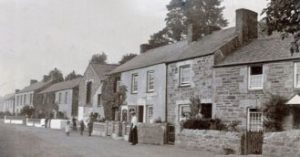 West-end Pentewan – Grandmother was born in a cottage to the far left of this photograph
West-end Pentewan – Grandmother was born in a cottage to the far left of this photograph
I started school at Mevagissey when I was three years old. There were two teachers: Miss Manfleet, mistress, and a Miss Blamey. We came back to Pentewan shortly after that and lived in a cottage at the village end of North Road. I then attended the Board School at the end of the village. There were over one hundred children in attendance at that time; they came from all the outlying farms. There were the Radcliffes from Nansladron, Webbs from Trenarren, Thomas from Hallane, Thomas and Stephens from Trevissick, Treleavens from Polglaze and Porthtowan, two Carveth families, Mr Stephen and Mr Walter Carveth’s children, Daveys from Tregassick, Stephens from Glentowan and Mattas from Hay. They walked in all weathers and if they arrived wet the teachers dried their clothing on the fire guards around the combustion stoves. Pasties brought in for lunch were also warmed there. Coming home from school we often had to wait for the engine and trucks to stop shunting across the road on the corner of the village at the West End. Mr Pearce, Rosie and Fred’s father was in charge of the crossing gates and we had to wait until he opened the gates to let us go by. Sometimes this would make us late for school. We would also often stop and watch the blacksmith at work either making a horseshoe or fixing one to a horse. This never failed to interest us. Some-days an old chimney sweep named Charlie, who came from St Blazey, would walk through the village and boys would shout names at him and he would pretend to chase them. I always kept well away as I was scared of him.
There was also an Italian woman who had a barrel organ with a monkey on top. She used to sing ‘Alley Balley Boo’; I was also scared of her. Mrs Jolly who lived in a cottage at West End had a parrot and in warm weather it was put outside in a cage. We children would be fascinated by it and would say, “Pretty Polly” to it and the parrot would call in a very shrill voice, ‘Mother’.
When I started school there were three teachers: Mr Tregenza, the master, Miss H Couch and Miss Underwood. At that time there were two Miss Hannah Couch’s at Pentewan, so we called them, big Hannah and little Hannah. Little Hannah later became Mrs Tremberth and big Hannah lived with her grandfather, Captain Couch, at Rock Cottage. The infants’ room had a gallery at one side and we thought it great fun to be higher than the teachers. The master, Mr Tregenza, was a man we all feared and respected. He was a Wesleyan local preacher and the President of our United Band of Hope weekly meetings. We always had a band and tea treat on Good Friday, this was held in the Board School and the band played in the grounds outside. It was always lovely weather and we wore no coats. My grandfather, Richard Matta, and one of his brothers, Stephen Matta, tried to stop this annual effort – they said it was not in keeping with Good Friday and the crucifixion. Some of the village lads composed a song about it;
Roll on Band of Hope,
Good work to be done,
We don’t care for Steve nor Dick,
We’re going to have some fun.
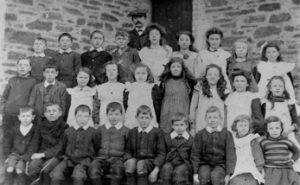 Pentewan school class circa 1907 – Grandmother is in the middle row fourth from the right
Pentewan school class circa 1907 – Grandmother is in the middle row fourth from the right
After Mr Tregenza left the village these meetings were discontinued. He went to a school at Moushole and a Mr Hitchins became our new master; he lived at Bay View. One of the teachers at the Board School, Miss Underwood, also ran a private school. We had a public bakehouse where Seabreezes is now – at the back. Nearly everyone took their baking to the bakehouse, one penny per article was the charge, and you would often see people taking tray loads of dinners, cakes, buns and so forth. Mr Williams, the owner of the bakehouse, was very crippled with arthritis and we would help him to lift the trays and dishes in and out of the oven. He used a kind of flat shovel with a long handle. We had six shops in the village: Mr Prynn, Misses Tyzzer, Captain Prettyman, Gates, Trudgian and Barbery. In 1911 my parents bought the business of the Central Stores from Captain Prettyman but not the premises. We did a lot of trade with the ships which came here with cargoes. We sold everything used on ships and needed by the sailors. There was no half-days then, we opened at 8.00am and didn’t close until after the Ship Inn had closed at 10.00pm. The vessels which came here with their cargoes often filled the dock and one could walk over the decks from one side of the harbour to the other side. They brought coal, flour, grain, cement and staves from Norway and Sweden. The staves were made into casks for transporting clay. We had two butchers’ shops in the village – Mr Williams and Mr Tucker – and five grocery shops: also a Mr Bowden called with his travelling shop.
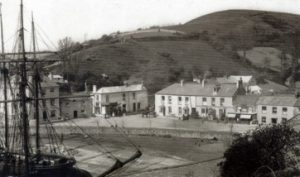 Looking down from above the harbour towards the square circa 1900
Looking down from above the harbour towards the square circa 1900
We had a railway which ran up to St Austell. It was driven by steam engines, one called ‘Canopus’ and the other ‘Pioneer’. Clay was brought down in the wagons by this railway and loaded into the hold of the vessels. The porters on the quay were paid one penny per ton for loading clay. When a coal boat was discharging one could have delivered a ton of coal for fifteen shillings. Sometimes Sunday schools from St Austell would come down on the railway trucks to the Winnick, arriving about 2.30pm and returning about 7.00pm or 8.00pm. There was always a truck laid on for Pentewan folk who wanted to ride to St Austell and back and often Mevagissey people would come with us. This was always great fun.
Sometimes a tugboat would come in the harbour to tow a vessel out to the bay. It always interested the children of the village and often it was the Gallant or the Countess of Jersey. We had an annual regatta, usually in August, and hobby horses, swing boats, hoopla stalls etc. would park in the square and on the harbour for several days. The Wesleyan Sunday school scholars held their tea treat always on a Whit Monday and the Bible Christians on the third Thursday in June. They each had a band, either from Foxhole or Sticker and they marched around the village over to the Winnick. The children were each given a free saffron bun weighing about 1lb known as a tea treat bun. After the children had their tea, a public tea followed, priced one shilling. We used to take a big urn over, light a fire under it to boil the water for the tea and a man would be employed for this job. In the evening we played games, ‘Grand Old Duke of York’, ‘Kissing Ring’, and ‘Tig’.
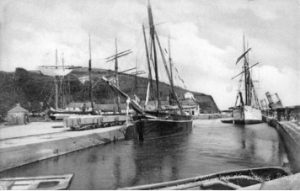 Pentewan Dock Basin circa 1900 clay loading shuts on the right of picture
Pentewan Dock Basin circa 1900 clay loading shuts on the right of picture
Our only means of transport in those days was by Cragg’s bus. It got in the village at 11.00am going to St Austell, returning just about 6.00pm. Captain Couch at Rock House, always travelled daily on it to his office at St Austell. Mevagissey people would say, ‘We must make room for Captain Couch’. He was a very big man and everybody had to squeeze up to make room for him.
We had to fetch our water from the village pump. Terrace people had their pump but they allowed the Davey’s and Barron’s to get their water there as they lived on the hill and this saved them coming down into the village. The Post Office was in a cottage just off the square, there were two assistants, Miss Nellie Pearce and Miss Prunella Clarke. The Postmaster was a Mr Truscott who carried the post around the village. He used a lantern during dark mornings as there were no street lights. Doctor Grier of Mevagissey held a surgery on Fridays from 2.00pm to 4.00pm in a room at Sea Breezes. A brass plate was placed on the railings in the front of the house stating this. Doctor Grier always rode on horseback and carried a black portmanteau bag. The children of the village were always under the impression that he brought all the new babies in this bag and a child from the village was heard to say, when a baby was still born, ‘No wonder the baby was dead, Dr Grier galloped his horse through the village like a mad thing’. Mr Beard carried the post to Heligan in the mornings and worked in his shoemaker’s shop in the afternoons. The shop was next to the Ship Inn. It was a meeting place for captains of vessels and men of the village. Other captains went into the Ship Inn but all those who were teetotal went to the cobbler’s shop. This was greatly missed when Mr Beard died. He was greatly missed too. Miss Rhoda Gaved conducted a Saturday morning class for religious instruction. This took place in the Anglican church and was non-denominational. Most children from the village attended and their reward was an annual treat which took place at Mr Shilson’s estate at Trewhiddle House. The children were taken there by the engine and trucks from the docks. I always envied them on these occasions and pestered my mother to let me join the class but was told that I could not join for the annual treat alone. In 1918 the Pentewan railway was sold and sent to France. Pentewan has not been the same since.”
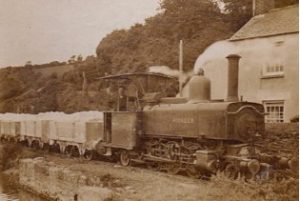 China clay train entering Pentewan August 1912 hauled by locomotive “Pioneer”
China clay train entering Pentewan August 1912 hauled by locomotive “Pioneer”
My grandmother’s recollections of life in the village are just some of the notes which I am lucky enough to have in my collection. I am pleased to be able to share her memories and hope that people find them interesting looking back to past times. The village is different today. There are no village shops, over a third of the properties are holiday and second homes, the harbour is practically a ruin, the entrance channel to the dock basin is silted up with sand and the pier is being destroyed by the heavy seas in the winter months. The Ship Inn survives, there are a couple of cafés and the large holiday complex caters for the large number of tourists who come to stay.
End notes:
1: GWR is the shortened and affection term for the Great Western Railway, offered referred to as “God’s Wonderful Railway”.
2: Domesday Book is a manuscript record of the “Great Survey” of much of England and parts of Wales completed in 1086 by order of King William the Conqueror.
3: John Leland, an English poet and antiquary, has been described as “the father of English local history and bibliography”.
4: Tonkin was a Cornish historian.

Robert Evans was born in his grand-mothers house on The Terrace at Pentewan and in 1981 following a change of employer was able to return to live in the house. He inherited his father’s collection of photographs and researched notes on the St Austell and Pentewan area and became interested in local and Cornish history. He is President and Chairman of Pentewan Old Cornwall Society, former Publications Officer for the Federation of Old Cornwall Societies and was made a Cornish Bard in 1989. Robert has presented talks on various aspects of Pentewan’s history including the Pentewan Railway to organisations all over Cornwall.

This was so very enjoyable and beautifully written. Thank you so much, Robert. An absolute treat to read during lockdown. Your grandmother had an amazing memory.
My great grandmother was a Tyzzer married a Birtwhistle a railway signnalmanin Burnley Lancashire circa 1880 l think she was resident in Pentewan before moving north with her family who were stone masons. l will have to check my data. I enjoyed reading about Pentewan, a place too visit when next in Cornwall. Thank you.
Glad you enjoyed the article Alan.
I thoroughly enjoyed your Grandmother’s memories. I live in Australia and have just found out that I am of Cornish descent. I hope to visit in 2022. One of my ancestors was a Couch.
Dear Mr Evans, I was very interested to read about bygone Pentewan because my family has a connection with the village. When I was young I was a regular visitor during the summer holidays, as my great-uncle, Fred Tremberth, lived there. He is mentioned in your grandmother’s memoir, as is his wife Hannah, the “little Hannah Couch”. I don’t know if Hannah was the Miss Couch who taught at the school. I believe that Fred was a Methodist local preacher. (His elder brother, the Rev William Tremberth, my grandfather, served as a Methodist missionary in China). John Tremberth
Rob, this is a fabulous recount of life in Pentewan. My great grandfather is also a Richard Matta from Mevagissey although his father was from Pentewan. We must be distant cousins!
My mum has always asked about the Matta name as her mum was a Matta and I’d be really keen to hear if you’ve it any further details of where it did originate – we’ve heard, Italian, Spanish and just a plain old misspelling of the Matters.
Thanks again for sharing such a brilliant recount.
I am Nancy Donald (nee Hackwell) in Australia, now 88. My mother was Winifred Gellard, born in Pentewan in 1899 0r 1900. My grandfather William Gellard was the village carpenter. He and Eliza (nee Kellow) came to Australia in 1912 with their 8 children. The picture of the schoolchildren shows Winifred and some of her sisters. I think her teacher was Mrs Vivian.
I last visited Pentewan in July 2019, as we were visiting my daughter who now lives in Kent.
What a wonderful memory your Grandmother had. I came across this after looking for more information on the history of Pentewan before our next visit in 4 weeks time. I took my family down from Ashton under Lyne to stay at the campsite last year and was intrigued to know more about the buildings, businesses and community gone by. This article, giving a first hand account, was beautiful to read. Thanks for sharing
This was very interesting and such a different way of life, far different from all the things we are experiencing these days, I would have liked to learn a bit more History about the village of Portgiskey and why it was abandoned, there doesn’t seem to be much on Google
What a lovely account of life in Pentewan a century or more ago. We had many childhood holidays in the area and my late Dad always visited the butchers shop ( you went up a few external steps to reach the door) to buy Hog’s Pudding.
Maybe you could solve a long standing family mystery? – when we would visit in the late 60s and early 70s, I distinctly recall that as you drove into the village and looked up to the left, there was a ship’s figurehead in a garden. All attempts to find anything out have met a dead end.
Would you happen to know anything about it please? Many thanks Graham Brown, Devizes, Wiltshire
Hello, our family are Treleavens from Polglaze Farm. My mother grew up there and told me tales of the gypsies that would winter over in the dip of the fields by the farm. They mended hedges and generally helped all through the winter. She told me of great great uncles who were captains of ships that’s sailed out to places such as Norway. We can trace our heritage back as far back as the 1500’s. My sister and I are coming down to Pentewan for a few days to give ourselves more memories. We are Cornish and proud.
Good story thanks. Do you have a photograph of the port in the 1860s possibly even with the brigantine ‘Palls’ there? I am writing a book involving a St Ives sea captain, William Henry Care,who used the port then, and on one occasion took a cargo of ‘rock salt’ from there to Ostend.